A Dye Gathering Trip
Nature’s Cauldron Farm is located in the Sierra Nevada foothills, at the edge of a large amount of backcountry leading into high mountain country. I am so very, very fortunate to live right where many people wait all year long to come on their summer vacation. So, last week DH and I took a mini-vacation, heading up to our other (and original) home at 5,000 feet elevation, and making a few forays into the uninhabited regions. We decided to avoid becoming fast food for mosquitoes by staying indoors, though I did miss camping under the stars at one of the region’s many lakes. Of course, some plants needed to be gathered off the ground for dye purposes!
First, we spent an afternoon at Harris Meadow, the place where our blender family of four children, along with assorted other children and adult companions, camped every Summer Solstice for over a decade. As the children grew up and moved out, we still went on regular visits to The Meadow, as it is known to us. This year, the area was still covered with snow at Summer Solstice, and we re-entered springtime last week, visiting with wild azaleas and California Pitcher Plants.
The pitcher plants are carnivorous, and considered rare throughout the mountains. We were happy to see them thriving at Harris Meadow, and also come upon an even larger stand of them in the region.

I haven't ever found a reference to the California Pitcher Plant as a dye plant, though it is used in flower essence therapy, and catches bugs for its meals. I am in awe of these plants.
Neither of these are dye plant choices, the pitcher plant because of its rare status. However, I was able to gather up lots of Letharia vulpina off the ground, the chartreuse lichen that adorns white firs and other conifers at this elevation. I am happy to be able to provide this lichen to the CSA shareholders, as I have successfully obtained the same shade of chartreuse from it without any mordant in the past. I also gathered lots of a second and equally common high country lichen that I am still trying to identify. I will post some photos of it separately, as well as on the Nature’s Cauldron Facebook page, and see if someone more expert at lichens can name it.
The second day of our little outing was spent jeeping through the old mining country.
We did have to stop a few times to jump into an inviting swimming hole! The water is still as cold as if it were June, and not early August, but we didn’t want to miss our chance.The third day included a lunch outing with at least 50 of DH’s Forest Service co-workers (great BBQ!), and a trip through the Sierra Buttes Lake Basin, where we were able to gather 15 pounds of lodgepole pine bark from two beetle-killed trees in about as many minutes!
This week has been back to business as usual, with plants getting cut for drying every day and dye material being packaged up for the first CSA shipment.
At least I know all these treasures are less than an hour away and I plan to get out and do more wildcrafting before the snow flies!

Lodgepole pine bark, harvested from beetle-infested dying trees, and packaged for the 1st 2011 CSA shipment.

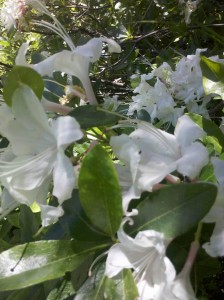
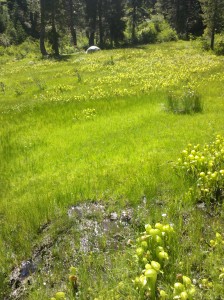
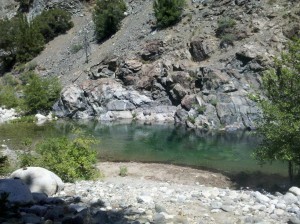
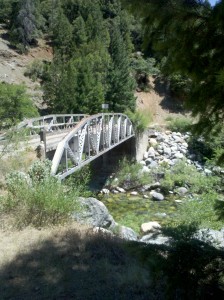
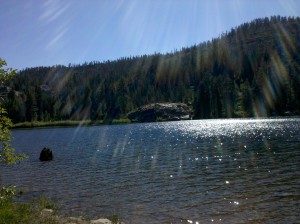







Hi – I *think* we’ve met, maybe… I used to live in Reno, and hung out with Sharon, Amy, and the gang.
I’ve done a fair amount of natural dyeing and think your CSA is a great idea!! I just had to note when you were talking about Letharia, however, that inhaling the fumes when this is cooking, can be toxic. I had the misfortune of developing an anaphylactic reaction to mushrooms (fungus) after moving to Oregon. When I dyed some yarn in my house (stove fan on, windows open), I found that I also reacted rather strongly to the vapors of this lichen.
As you said, the color produced is the same as the lichen, even on unmordanted yarn, and smells like the woods (which now make me sneeze!). I have found that it is not very light fast, and fades to a very light yellow. I haven’t been eager to try it again with a mordanted yarn to see if it makes a difference!!
Thanks for sharing that! I have used it myself without that reaction, and it DOES smell like the woods, however I guess the outcome could have been different, and I could have reacted to it as well. I made a bag with the yarn, so haven’t ever needed to wash it. The color has remained true for over a decade. I will recommend using this lichen to dye outdoors only, or possibly using one of the cold soak, or solar dye methods.
I also work with letharia vulpina and use alum for mordant. The color of the dye is pretty much the same as the lichen itself but more vibrant yellow (less green) and it seems to be color fast lasting for years. I do my dyeing outside and have not experienced any negative reactions with this plant nor have I heard any complaints from my dye workshop students. (probably a good idea not to inhale the fumes though) The lichen is konwn to be lethal to wolves, hence it’s latin name, so handle it with care and make sure to keep it away from pets.
My package of dye plants was waiting for me when I returned from Europe 9/13 2011. I plan to start dyeing next week.
Thanks a lot.
Anni